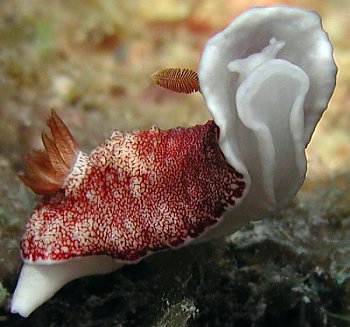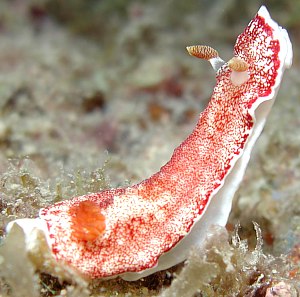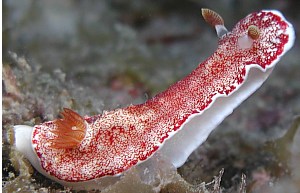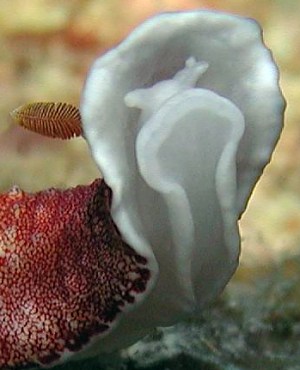Chromodoris tinctoria - head waggling behaviour
November 11, 2002
From: Kheong Sann Chan

Hi Bill,
On a dive trip to Pulau Dayang, Malaysia, this weekend, we came across a Chromodoris tinctoria. It looked like it was going somewhere and lifted its head as if it was trying to find it's way. Did not notice this behaviour in any nudibranchs before, wondering if you have any explanation for it?
Depth: 13m
Date: 3 Nov 2002
Location: Pulau Dayang, Malaysia
Kheong
kschan@mail.dsi.nus.edu.sg



Dear Kheong,
This behaviour is fairly normal for many dorids and other nudibranchs. I have discussed some aspects of this on the Dorid Head Page. Nudibranchs can't see, because their eyes are very poorly developed, so when they are 'looking' for something they have to do it by touch or smell. Although all parts of their body are sensitive to touch, the edge of the mantle, the anterior edge of the foot, and the oral tentacles seem to be constantly 'feeling' the substrate as the animal crawls along. To 'smell' potential food objects, and perhaps potential mates, nudibranchs use their chemosensory organ, the rhinophore. Lifting and waving the anterior end of the body around, as you describe and illustrate in your photo, is the nudibranchs way of 'searching around' for useful stimuli. It can help it find a rock or a sponge which is just above it, and it can help it locate the source of a scent in the water. If its two rhinophores are waved from side to side, even its little brain can balance the unequal stimuli reaching each rhinophore, and so determine the direction in which it is necessary to move to reach the source of the scent or smell.
Best wishes,
Bill Rudman
Related messages
-
Mouth parts of some chromodorids
From: Bob Whorton, July 1, 2005
